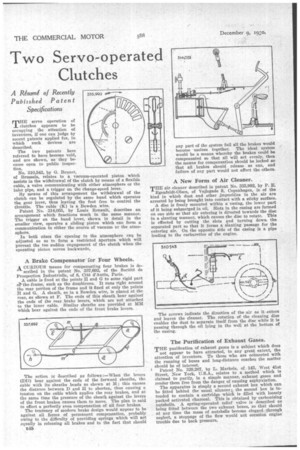Two Servo-operated Clutches
Page 66

If you've noticed an error in this article please click here to report it so we can fix it.
A IVsurne' of Recently Published Patent Specifications
THE servo operation of clutches appears to be occupying the attention of inventors, if one can judge by recent ratents applied for, in which such devices are described.
The two patents here referred to have become void, and are shown, as they became open to public inspection.
No. 810,543, by G. Bruner, of Brussels, relates to a vacuum-operated piston which assists in the withdrawal of the clutch by means of a flexible cable, a valve communicating With either atmosphere or the inlet pipe, and a trigger on the change-speed lever.
By means of this arrangement the withdrawal of the clutch can be regulated by the same hand which operates the gear lever, thus leaving the foot free to control the throttle. The cable (K) is a Bowden wire.
Patent No. 314,055, by Louis Renault, describes an arrangement which functions much in the same manner. The trigger on the hand lever, shown in detail in the smaller view, operates a sliding piston which can form a communication to either the source of vacuum or the atmosphere.
In both cdsea the opening to the atmosphere can be adjusted so as to form a restricted aperture which will prevent the too sudden engagement of the clutch when the operating piston moves backwards.
A Brako Compensator • for Four Wheels.
A CURIOUS means for compensating four brakes is described in the patent No. 337,692, of the Societe de Prospection Industrielle, of 8, Cite d'Antin, Paris. A cable is fixed at the points EL and G to some rigid part ol-the,frame, such as the dunthirons. It runs right around the rear portion of the frame and 0 fixed at only the points H and G. A sheath, as in a Bowden wire, is placed at the rear, as shown at F. The ends of this sheath bear against the ends of the rear brake levers, which are not attached to the inner cable. Similar sheaths are provided at MM which bear against the ends of the front brake levers.
The action is described as follows :—When the levers (DD) bear against the ends of the forward sheaths, the cable with its sheaths bends as shown at M.; this causes the distance between D and II to shorten, thus causing a tension on the cable which applies the rear brakes, and at the same time the pressure of the sheath against the levers of the front brakes causes them to move. The plan is said to effect a perfectly even compensation of all four brakes.
The tendency of modern brake design would appear to be against all forms of permanent compensation, probably owing to the difficulty of providing springs which will act equally in releasing all brakes and to the fact that should
148
any part of the system fail all the brakes would become useless together. The ideal system would be a means whereby the brakes could be compensated so that all will act evenly, then the means for compensation should be locked so that all brakes should release as one, and failure of any part would not affect the others.
A New Form of Air Cleaner. .
THE aircleaner described in patent No. 335,992, by P. E. Egenfeldt-Olsen, of Vejlegade 9, Copenhagen, is of the kind in which dust and other ...impurities in the air are arrested by being brought into contact with a sticky surface.
A disc is freely mounted within a casing, the lower part of it being submerged in oil. Slots in the casing are formed on one side so that air entering is directed towards the disc in a slanting manner, which causes the disc to rotate. This is effected by cutting the slots and turning down the separated part so that it forms a slanting passage for the entering air. On the opposite side of the casing is a pipe leading to the carburetter of the engine.
The arrows indicate the direction of the air as it enters and leaves the cleaner. The rotation of the cleaning disc enables the dust to separate itself from the disc while it is passing through the oil lying in the well at the bottom of the casing.
The Purification of Exhaust Gases.
THE purification of exhaust gases is a subject which does
not appear to have attracted, to any great extent, the attention of inventors. To those who are connected with the running of buses and long-distance coaches the matter should be of interest.
Patent No. 329,267, by L. Markets, of 145, West 41st Street, New York, U.S.A., relates to a method which is claimed to purify, in a simple manner, exhaust gases and render them free from the danger of causing asphyxiation.
The apparatus is simply a second exhaust box which can be fitted behind the usual silencer the second box is intended to contain a cartridge which is filled with loosely packed activated charcoal. This is obtained by carbonizing nutshells. A spring-operated relief valve is described as being fitted between the two exhaust boxes, so that should at any time the mass of nutshells become clogged through neglect, a stoppage of the flow would not occasion engine trouble due to back pressure.




































































































